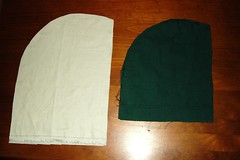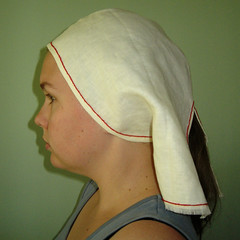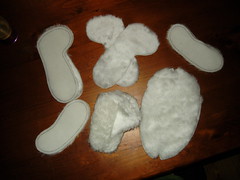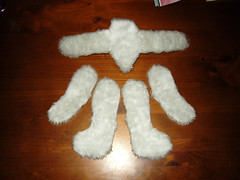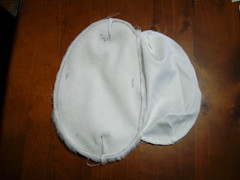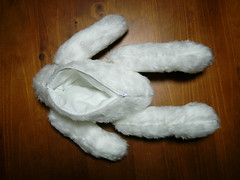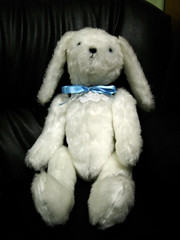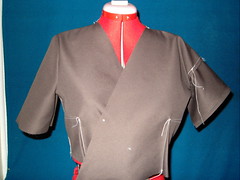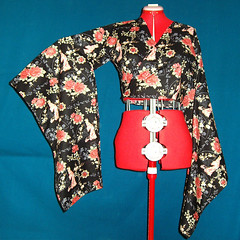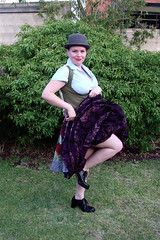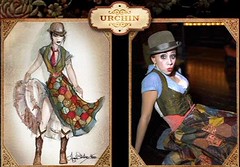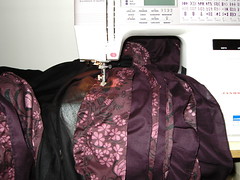Thursday, January 25, 2007
Jorvik Cap
Difficulty: Easy
Total Time: approx 6 hours
The accepted pattern for the Jorvik cap is generally a rectangle which has a seam sewed to fit to the curve of the head. The caps of this kind found in Jorvik had this part tailored so that the cap was curved (as in the one I have made), however in Dublin the material was not cut, leaving a point created by the seam.
To fit my head better I tailored the curve a little more and ended up sewing this in two pieces. This also allowed me to leave the seam open at the back of the neck so that my hair won't becom too bunched up underneath. Fitting something to the head can be hard, so I had help with checking how the seam was lying on the mockup and alterating the length of the cap.
I sewed and hemmed the cap by hand using linen thread, then used wool embroidery wool to do some decorative stem stitch around the outisde. The linen ties were also hand sewed, then attached to the cap.
The generally accepted way of wearing this style of hood is with the strap under the chin and flaps hanging down over the ears, however I find it much more comfortable to tie it like a scarf at the back of my neck (as shown), which should keep my hair out of my face better as well.
Wednesday, December 13, 2006
Earrings
Difficulty: Easy
Total Time: 1 hour
These aren't hard to make, they're just fiddly. I never knew that hand crafted jewellery could look this good though. I really like using jump rings and head pins. I bought myself some earring hooks and silver chain as well as the pretty heart spacer charms and put it all together with some real garnet and real peridot. The only other things needed are two pairs of small pliers and a bit of patience coupled with some creativity.


The first set are garnet (2 x 6mm and 18 x 4mm), 2 heart accents, 10 head pins, 12 jump rings and 2 earring hooks.
The second set are peridot (2 x 5mm, 6 x 4mm), 2 jump rings, silver chain and 2 earring hooks.
Thursday, December 7, 2006
Petticoats
Difficulty: Easy
Total Time: 4 hours
These petticoats really aren't all that hard. I now know that I simply made some errors in fabric choice and was far to gentle which proved the downfall of my first petticoat.
First get a decent cotton or poly/cotton as the base of the petticoat. You really don't want to work with anything shiny, slippery or light weight because you just won't be able to sew the netting to it.
Second, get yourself some netting. You want the normal netting, not the bridal stuff because the bridal netting is just too thin and doesn't give that nice "poomf" when you put your garments on overtop.
The petticoats from Gosu Rori magazine have a tapered shape as the base of the skirt. Sew the two halves together and then mark out where you will sew the netting to make it easier to pin and control. Hem the bottom of the petticoat now if you need to because the netting will make that hard later on. Put this part aside for a minute.
Cut out your lengths of netting (mine were one length of 2.6m x 33cm and one length of 1.6m x 25cm) and gather one side. Pin one length along the line on your base material and stitch into place. Then pin the next length along the other line and stitch.
Sew your waistband onto the top of the skirt and insert your elastic, and you're done!
You can be quite rough with the netting. You won't hurt it!! Make it conform to where you want to sew... and worse case - remember it is going under your garment and doesn't need to look perfect.
If you find the netting is scratching on your legs you might have made the netting ruffles a little too long. Trim them a centimetre or two all the way around so that the netting is above the cotton base and then the cotton should protect your legs.
Wednesday, December 6, 2006
Bunny Bag
Difficulty: Easy
Total Time: 6 hours
I photocopied the pattern out of Gosu Rori vol 4, but the pattern itself could be adapted to any soft toy where you can put a zip up the back. I only got cheap toy fur because I am probably only going to use the bag once and at the beginning I wasn't sure how it would turn out and didn't really want to spend up to $60 on fur. So my "scrooge" side won out on this one.
I used about 60cm of fake fur. One tip is to make sure you pay close attention to the way the fur will go. I drew each piece on to the back of the fur, but if you do that make sure you two each of the front and back of the pieces (ie. you need to turn over your paper pieces and do the other side too)
Next carefully cut the fur out. Because the fabric is fur you need to try to cut between the fur follicles. You can see why by having a look at where the shop assistant cut the fur. It is all ratty because the fur was cut through. You need to try not to cut through the fur, just the backing material.
Finally you can start to sew the pieces together. For the head I sewed the ears into the top seams where the gusset joins the sides of the head together. The arms, legs and ears are all relatively straight forward to sew together. After each piece is together turn it the right way and carefully pull the fur out of the seam lines.
The instructions for the body didn't include a lining for the bag itself and I wondered how the bunny would look if it had my wallet, keys and other things inside without having a little stuffing in there too so that he keeps his shape. I used the original body pattern to draw a smaller shape for my gusset and cut it out of white cotton. First I sewed the zip onto the fur and sewed around the fur leaving a small opening in the front. Next I sewed both pieces of cototn lining to the zip as well so that all the seams would end up in the bunnies tummy. Then I sewed around the lining without leaving a gap. I could turn the stomach in the right way through the gap in the fur seam and then after attaching the arms and legs (described next) I lightly stuffed either side of the stomach lining.
I used some blue toy eyes and some simple plastic arm and leg joints which you can get from the "teddy bear" area in your craft shop. With some of these things you either need to be quite strong to put them together, or use a pair of pliers. You can join each of the arms and legs to the body and then stuff the arms and legs and sew the holes closed.
Finally the head is stitched to the top of the body with a piece of ribbon coming out of the back of the neck seam as a handle. Then I added some lace and a blue ribbon around his neck and stitched on his nose with black cotton embroidery thread.
Tuesday, November 14, 2006
Wa-Lolita Dress
Difficulty: Easy
Total Time: 35 hours
The dress was a design from Gosu Rori vol 7. I constructed a mock up of the top of the dress to ensure the sizing was correct and deliberated for a while over the sleeves. I wasn't sure if the sleeve design would work because when I tried it I found that there was quite a noticeable crease near the arm pit on my mock up.
I constructed a second set in sleeve and tried this, however I then felt that the sleeve was too fitted and was not in keeping with the Kimono-style of a wa-loli dress. You can see from the photo the two types of sleeves I tried and here are the patterns for each.
I constructed a second mock up using a lighter material which more closely matched the printed cotton material I had chosen for the dress and found that actually the creasing around the arms wasn't as noticeable as I'd thought it would be, therefore I decided to plow ahead.
The dress itself was very easy to construct. My only downfall was the printed material. I wanted to try to keep the geisha design upright, so I had cut my material carefully and sewn each piece together after carefully lining up the sections. I started taking some progress shots after sewing the sleeves together and then noticed a big issue through my view finder. Because of the way the sleeves were put together one side of each sleeve was up the wrong way. I had to unpick both sleeves completely and cut them in half so that I could have the pattern the right way up on both sides.
The bottom of the dress was never going to be up the right way, so I just sewed it as best as I could. The collar was partially hand sewn, which was the most time consuming part, but for the majority of the hemming I used the machine.
The corset was a simple pattern which I had already used once for the corset of my Urchin cancan dress . I altered it a little to see if it would work better if I had a squarer design. I am not 100% happy with it, but it did the job. One point was that I should have been more careful with the poly boning because I didn't trim it accurately this time and it starts to poke out through the material.
The material of the corset itself was cut to allow the majority of the pattern to show. It had an intermittent pattern which I wanted to utilize in the body of the corset. I also had to be careful that I used the right sides together because one side up was blacker than the other side when it caught the light.
I purchased my geta from an ebay seller in the US. They arrived really quickly, and although simple they did the job. Unfortunately my puppy decided they were a good chew toy at one stage and took a chunk out of one of the sides, but thankfully no-one noticed on the day.
Saturday, September 16, 2006
Moulin Rouge
Difficulty: Medium-Hard
Total Time: 60 hours
Putting it all together involved a lot of items, but I was happy with the end result.
Grey Bowler hat - purchased from ebay.
Blue shirt - purchased and altered to short sleeves.
Waist Cincher - Handmade with article here
Vest - Handmade with article here
Skirt - Handmade with article here
Bloomers - Handmade with article here
Shoes - Second hand store platform shoes
Friday, September 15, 2006
Moulin Rouge - Urchin CanCan Skirt
The patchwork looked to be the most time consuming part of this project and I decided that I would begin there because it was something I thought I could manage with minimal advise. If I didn't make a start I thought I never would!
I bought ten colours of cotton quilters material and spent around 5 hours with a hexagon template cut from cardboard drawing hexagons and cutting material... What a job! Each Hexegon is 12cm across in each direction giving me a centimetre seam allowance all the way around. I tried to keep the colours in darker neutral shades as I interpret the photos from the Moulin Rouge.
Just when I thought I would surely slip into madness it was over and I could begin sewing... right after I ironed every single patch (another tedious task).
The sewing progressed a lot quicker than I thought and after not too much deliberation I had two rows of patches sewn. I decided to sew concentric circles of patches so that I ended up with a circle without any obvious break in the pattern.
Over several days and several more hour long sessions I was up to the sixth row of patches. Although I thought it would be more difficult the hexagon shapes are joining together quite easily. I think sewing them in circles helps to fix any small errors that may creep in.
Of course I am not too worried about this being completely flat like a quilt, but I was worried that keeping it in two pieces would warp the pattern when it came to sewing up the sides. My original idea was to sew a zip or some kind of fastening into either side to enable the skirt to be put on without breaking the pattern with anything. I think now that I will use elastic around the waste as this should be covered with the waist cincher.
I finally found the colour for the petticoat ruffles! I don't know how many times I've freeze-framed the movie looking for shots of urchin and finding only a few un-useful shots. The screen capture I found shows Urchin’s petticoats which are purple; very different from the design sketches. What great timing for me, merely hours from going shopping for the petticoat material (which I nearly bought in cream two days ago!)
I bought cotton voile in three colours - black, plum and floral plum. The black was used as a base for the ruffles which is a simple circle skirt 80cm long. Next I mass produced ruffles by cutting lengths 13cm wide and doing a rolled hem on one side and a zigzag on the other. A machine that can do a rolled hem is extremely handy to have. Cotton voile apparently doesn't fray if it is ripped along the weft, but I didn't want to take any chances and I have a lovely finish even though it took much longer.
Eight layers later the ruffles are starting to look great and took 5 metres of material to construct. The plum was not as wide as the patterned material so I had initially bought three metres of it and two of the patterned. The first ruffle took 6 metres of material and the 8th took 4 metres.
A few more layers and I'll be up to my waist and able to attach the patchwork to the other side. These layers took me another 4 evenings to complete and believe me I am very tired of ruffles!
I realized that I had extremely underestimated the amount of material I would need for the grey border around the bottom of the skirt. I had bought only half a metre, but I really need a complete circle strip because a straight stip would not sit flat because the skirt is constructed from a simple circle skirt pattern. I bought 3 more metres of grey but as it was only 114cm wide I had to improvise for the back and cut it out of two pieces.
I have just made enough patchwork to go up to the grey border which was constructed out of two half circle strips. The ruffle skirt was attached around the grey border and then the patchwork was trimmed to the waist and attached to the waistband. One problem I encountered was not only that the black ruffle base was slightly larger than my patchwork circle (despite careful measuring), but also that the ruffles are so heavy that I had to use umpteen tacking stitches under the first ruffle into the inner side of the grey border to hold the ruffles in place better.
More photos of the construction on flickr.

